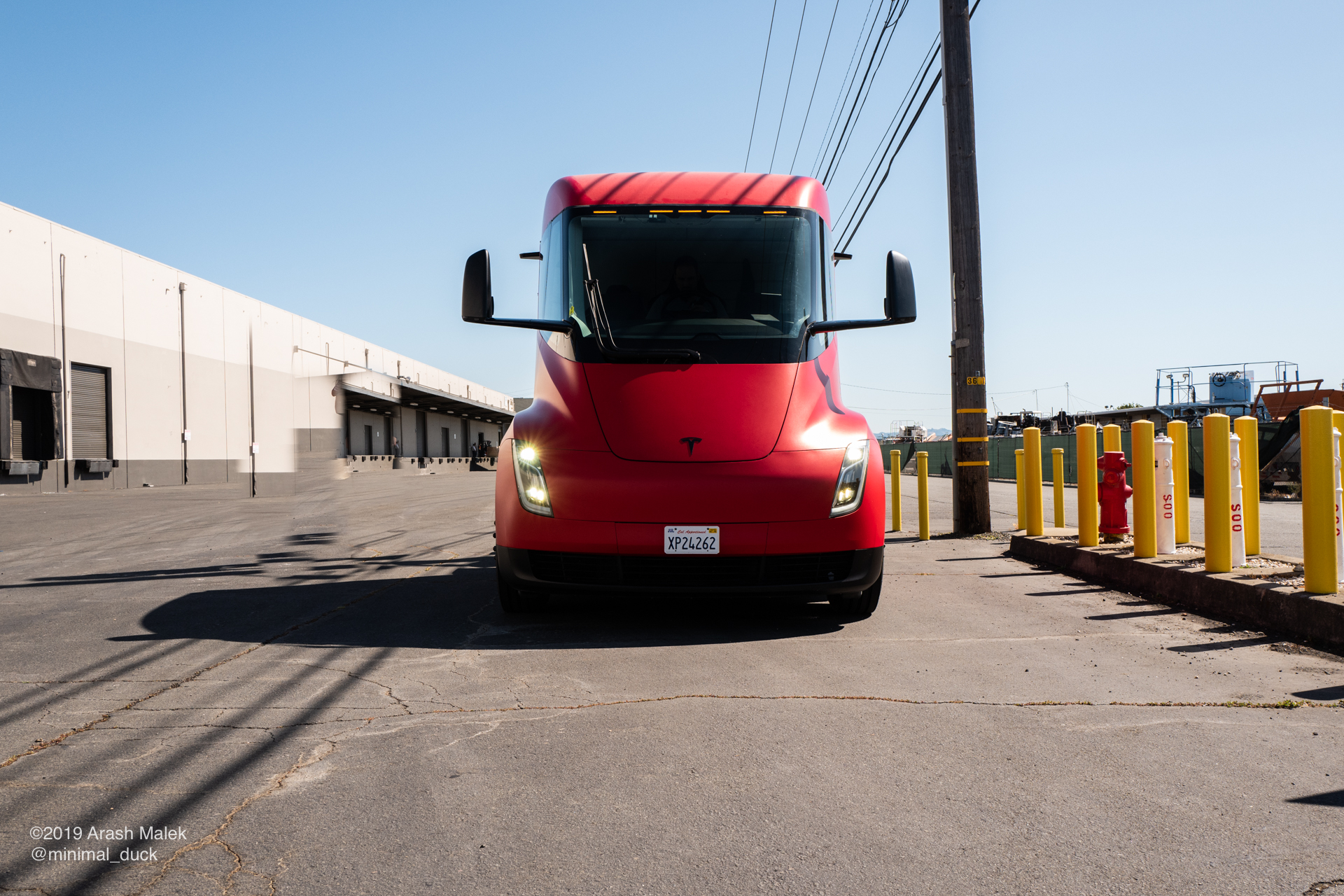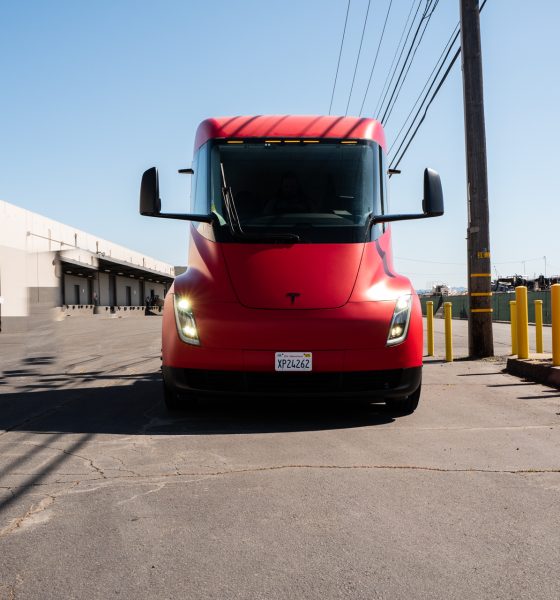

News
Tesla Semi battery weight criticisms are rooted in outdated ideas: EV expert
A good number of skeptics critical of battery-electric long-haulers like the Tesla Semi typically argue that the weight of the vehicles’ batteries makes them ineffective against competitors that are powered by diesel or hydrogen. As noted by an electric vehicle veteran and expert recently, however, these ideas are rooted in outdated ideas about battery weight. And if one considers more recent battery tech, electric Class 8 trucks may not only be feasible; they may actually be closer than expected.
In a recent piece on Bulk Distributor Magazine’s November/December 2020 issue, Auke Hoekstra, Senior Advisor for Electric Mobility at the Eindhoven University of Technology, noted that contrary to popular belief, long-haul trucks would not be the last vehicles to become battery-powered. This is in no small part due to the advancement of battery technology. Hoekstra noted that within five years, he believes that “electric trucks will become the logical choice for many bulk transporters” And within 10 years, vehicles like the Tesla Sei will likely dominate new sales.
The stunning progression of battery technology could be seen in just how much batteries have gotten better and cheaper over the years. Hoekstra noted that myths about electric trucks being too heavy were true 20 years ago, but not today. If electric long-haulers existed 20 years ago, they would likely be powered by lead-acid batteries, and assuming a battery size of 1 MWh, such a vehicle will require a pack that will likely weigh about 25 tons. That’s more than the entire payload of the truck. This is, of course, not the case today.
Hoekstra noted that when he wrote his first book about electric vehicles for the Dutch Ministry of Road Transport 13 years ago, lithium-ion batteries had started to emerge. Lithium-ion batteries offered reductions in weight, resulting in a 1 MWh pack weighing only about 10 tons. Today, this is even better, with modern electric cars having batteries that weigh about 5 kg per kWh or 5 tons per MWh. “I expect that with five years, that weight will be down to 3.5 tons. And it doesn’t stop there,” the EV veteran wrote.
Class 8 trucks like the Tesla Semi, which are designed from the ground up to be electric, will likely offer even better weight advantages. Hoekstra estimated that Tesla would see further weight reductions of about 2.5 to 3 tons due to the vehicle’s all-electric platform. “The electric motor is lighter, and you can get rid of the diesel tank and exhaust treatment. Then you place the electric motors between the wheels and lose the differential, driveshaft, and a host of other components,” he wrote.
What’s particularly interesting is that these estimates don’t even take into account the innovations that Tesla unveiled in its Battery Day event. Once Tesla’s 4680 tabless cells and structural battery packs enter the equation, the Semi becomes an even more compelling alternative to diesel-powered trucks. Hoekstra estimated that Tesla’s structural battery packs could save another ton to the Semi’s overall weight, seeing as the battery would practically displace the steel beams that give traditional Class 8 long-haulers their rigidity. With this in mind, the EV veteran noted that “battery weight will soon be a problem of the past.”
There are other advantages to electric trucks that were highlighted by Hoekstra in his piece, such as the cost savings that will result from the use of a fleet of electric trucks. This is something that Tesla has highlighted in the past, with CEO Elon Musk stating during the vehicle’s unveiling that the Semi will vastly undercut diesel-powered rivals when it comes to operating costs. Couple this with the low maintenance requirements of EVs, as well as the fact that batteries now last much longer, and trucks like the Tesla Semi will likely become very attractive options for operators in the very near future.

Elon Musk
Starlink passes 9 million active customers just weeks after hitting 8 million
The milestone highlights the accelerating growth of Starlink, which has now been adding over 20,000 new users per day.

SpaceX’s Starlink satellite internet service has continued its rapid global expansion, surpassing 9 million active customers just weeks after crossing the 8 million mark.
The milestone highlights the accelerating growth of Starlink, which has now been adding over 20,000 new users per day.
9 million customers
In a post on X, SpaceX stated that Starlink now serves over 9 million active users across 155 countries, territories, and markets. The company reached 8 million customers in early November, meaning it added roughly 1 million subscribers in under seven weeks, or about 21,275 new users on average per day.
“Starlink is connecting more than 9M active customers with high-speed internet across 155 countries, territories, and many other markets,” Starlink wrote in a post on its official X account. SpaceX President Gwynne Shotwell also celebrated the milestone on X. “A huge thank you to all of our customers and congrats to the Starlink team for such an incredible product,” she wrote.
That growth rate reflects both rising demand for broadband in underserved regions and Starlink’s expanding satellite constellation, which now includes more than 9,000 low-Earth-orbit satellites designed to deliver high-speed, low-latency internet worldwide.
Starlink’s momentum
Starlink’s momentum has been building up. SpaceX reported 4.6 million Starlink customers in December 2024, followed by 7 million by August 2025, and 8 million customers in November. Independent data also suggests Starlink usage is rising sharply, with Cloudflare reporting that global web traffic from Starlink users more than doubled in 2025, as noted in an Insider report.
Starlink’s momentum is increasingly tied to SpaceX’s broader financial outlook. Elon Musk has said the satellite network is “by far” the company’s largest revenue driver, and reports suggest SpaceX may be positioning itself for an initial public offering as soon as next year, with valuations estimated as high as $1.5 trillion. Musk has also suggested in the past that Starlink could have its own IPO in the future.
News
NVIDIA Director of Robotics: Tesla FSD v14 is the first AI to pass the “Physical Turing Test”
After testing FSD v14, Fan stated that his experience with FSD felt magical at first, but it soon started to feel like a routine.

NVIDIA Director of Robotics Jim Fan has praised Tesla’s Full Self-Driving (Supervised) v14 as the first AI to pass what he described as a “Physical Turing Test.”
After testing FSD v14, Fan stated that his experience with FSD felt magical at first, but it soon started to feel like a routine. And just like smartphones today, removing it now would “actively hurt.”
Jim Fan’s hands-on FSD v14 impressions
Fan, a leading researcher in embodied AI who is currently solving Physical AI at NVIDIA and spearheading the company’s Project GR00T initiative, noted that he actually was late to the Tesla game. He was, however, one of the first to try out FSD v14.
“I was very late to own a Tesla but among the earliest to try out FSD v14. It’s perhaps the first time I experience an AI that passes the Physical Turing Test: after a long day at work, you press a button, lay back, and couldn’t tell if a neural net or a human drove you home,” Fan wrote in a post on X.
Fan added: “Despite knowing exactly how robot learning works, I still find it magical watching the steering wheel turn by itself. First it feels surreal, next it becomes routine. Then, like the smartphone, taking it away actively hurts. This is how humanity gets rewired and glued to god-like technologies.”
The Physical Turing Test
The original Turing Test was conceived by Alan Turing in 1950, and it was aimed at determining if a machine could exhibit behavior that is equivalent to or indistinguishable from a human. By focusing on text-based conversations, the original Turing Test set a high bar for natural language processing and machine learning.
This test has been passed by today’s large language models. However, the capability to converse in a humanlike manner is a completely different challenge from performing real-world problem-solving or physical interactions. Thus, Fan introduced the Physical Turing Test, which challenges AI systems to demonstrate intelligence through physical actions.
Based on Fan’s comments, Tesla has demonstrated these intelligent physical actions with FSD v14. Elon Musk agreed with the NVIDIA executive, stating in a post on X that with FSD v14, “you can sense the sentience maturing.” Musk also praised Tesla AI, calling it the best “real-world AI” today.
News
Tesla AI team burns the Christmas midnight oil by releasing FSD v14.2.2.1
The update was released just a day after FSD v14.2.2 started rolling out to customers.

Tesla is burning the midnight oil this Christmas, with the Tesla AI team quietly rolling out Full Self-Driving (Supervised) v14.2.2.1 just a day after FSD v14.2.2 started rolling out to customers.
Tesla owner shares insights on FSD v14.2.2.1
Longtime Tesla owner and FSD tester @BLKMDL3 shared some insights following several drives with FSD v14.2.2.1 in rainy Los Angeles conditions with standing water and faded lane lines. He reported zero steering hesitation or stutter, confident lane changes, and maneuvers executed with precision that evoked the performance of Tesla’s driverless Robotaxis in Austin.
Parking performance impressed, with most spots nailed perfectly, including tight, sharp turns, in single attempts without shaky steering. One minor offset happened only due to another vehicle that was parked over the line, which FSD accommodated by a few extra inches. In rain that typically erases road markings, FSD visualized lanes and turn lines better than humans, positioning itself flawlessly when entering new streets as well.
“Took it up a dark, wet, and twisty canyon road up and down the hill tonight and it went very well as to be expected. Stayed centered in the lane, kept speed well and gives a confidence inspiring steering feel where it handles these curvy roads better than the majority of human drivers,” the Tesla owner wrote in a post on X.
Tesla’s FSD v14.2.2 update
Just a day before FSD v14.2.2.1’s release, Tesla rolled out FSD v14.2.2, which was focused on smoother real-world performance, better obstacle awareness, and precise end-of-trip routing. According to the update’s release notes, FSD v14.2.2 upgrades the vision encoder neural network with higher resolution features, enhancing detection of emergency vehicles, road obstacles, and human gestures.
New Arrival Options also allowed users to select preferred drop-off styles, such as Parking Lot, Street, Driveway, Parking Garage, or Curbside, with the navigation pin automatically adjusting to the ideal spot. Other refinements include pulling over for emergency vehicles, real-time vision-based detours for blocked roads, improved gate and debris handling, and Speed Profiles for customized driving styles.








